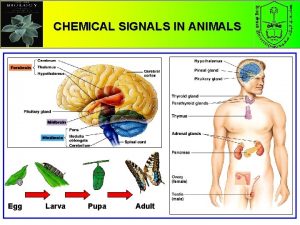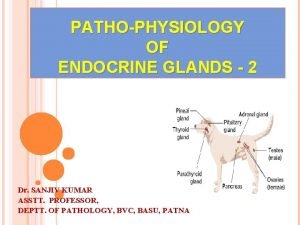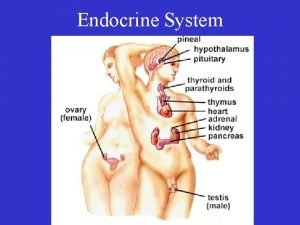PATHOPHYSIOLOGY OF ENDOCRINE GLANDS Dr SANJIV KUMAR ASSTT



















- Slides: 19

PATHO-PHYSIOLOGY OF ENDOCRINE GLANDS Dr. SANJIV KUMAR ASSTT. PROFESSOR, DEPTT. OF PATHOLOGY, BVC, BASU, PATNA

Endocrine disorders may be subdivided into three groups: Endocrine gland hyposecretion (leading to hormone deficiency) Endocrine gland hypersecretion (leading to hormone excess) Tumours (benign or malignant) of endocrine glands

PITUITARY GLAND


HYPERPITUITARISM This condition is manifested by overgrowth and proliferation of bones. In man this is called “Gigantism” in young growing individuals in whom the ossification of bone has not yet stopped and “Acromegaly” in adults in whom no more growth occurs. Gigantism is due to increased secretion of somatotropin in the young. The individual grows very tall and the skin and subcutaneous tissues show fibrous hyperplasia. Since STH is diabetogenic, glycosuria is a symptom. If the patient lives beyond the age of epiphyseal fusion acromegaly may result.


Acromegaly (akros=extremity; megale=enlarged) The hands and the feet are abnormally large and the fingers are crooked and knotty. The facial bones become long and thick, especially the jaw, resulting in prognathism. Nose, lips and ears become large. Viscera are enlarged (splanchnomegaly or macrosplanchnia) and fibrous hyperplasia of skin and subcutaneous tissue. Kyphosis is also seen in some. Impotence in the male and amenorrhoea in the female are the other symptoms. Diabetes mellitus occurs due to diabetogenic action of the hormone. Eye lesions may be noticed due to pressure on the optic chiasma by the tumor


HYPOPITUITARISM Causes of pituitary hypofunction Pressure by: a) Tumors b) Cysts Inflammation and sclerosis Infarction and necrosis Hydrocephalus – bulging of the floor of the ventricles Abnormal development Tuberculosis Pituitary dwarfism or infantilism Hypofunction in the young children causes in pituitary Dwarfism or Infantilism. This condition is not seen in animals.


Simmond’s disease (Pituitary cachexia) or Sheehan’s Syndrome This condition is described in female dogs, due to postpartum necrosis of the pituitary consequent on thrombosis following hemorrhage. Clinical signs Severe cachexia, loss of sexual function, weakness, low metabolic rate, loss of hair and pigmentation, mental apathy, drowsiness, microsplanchnia, extreme dehydration and emaciation. Lesions Atrophy and fibrosis of the thyroid, adrenal glands, ovaries and parathyroids together with the symptoms and lesions consequent on the deficiency of the hormones secreted by these glands and structures.


Frohlich’s Syndrome- Dystrophia adiposogenitalis This develops probably due to the pressure by a tumor or hydrocephalus and is mostly found in females. Decreased level of gonadotrophins. Clinical signs � Obesity: There is disproportionate accumulation of fat. � Genital hypoplasia and decreased sexual function � Idiocy or mental retardation � Thin skin and hair � Reduced sweat secretion


DIABETES INSIPIDUS In Hypo secretion of ADH, reabsorption of water from the glomerular filtrate does not occur and so large quantities of urine with low specific gravity are passed and this condition is known as diabetes insipidus. Lesions of the pars nervosa or any causes that injure the hypothalamus will produce diabetes insipidus. Causes are: Trauma- surgical or fractures Pituitary tumor or metastases form. Meningitis- pressing on the stalk/ Encephalitis.

TUMOURS OF PITUITARY GLAND Chromophobe adenoma, acidophilic adenoma and basophilic adenoma of pituitary were rarely reported. Carcinoma of the above three types of cells may be noticed. But these are only locally invasive.

PINEAL GLAND


Pineal gland is a tiny gland located above the posterior extremity of the third ventricle of brain. It secrets a hormone called melatonin. Melatonin antagonizes the action of the melanocyte stimulating hormone. It inhibits thyroid hormone secretion rate and secretion of the adrenal steroids. Pineal dysfunction Pineal hyperfunction is associated with delayed puberty. Pineal hypofunction results in precocious puberty. Neoplasms of pineal gland Tumors reported in pineal gland include pinealoma, glioma and teratoma.
 Asstt theorem
Asstt theorem Holocrine gland
Holocrine gland Endocrine glands
Endocrine glands Hyophysis
Hyophysis Are endocrine glands ductless
Are endocrine glands ductless Endocrine glands
Endocrine glands Major endocrine glands male and female
Major endocrine glands male and female Endocrine glands
Endocrine glands Thyroiditis
Thyroiditis What are chemical signals
What are chemical signals Chapter 16 matching questions 1-5
Chapter 16 matching questions 1-5 Rat urinary system
Rat urinary system Whats the difference between endocrine and exocrine glands
Whats the difference between endocrine and exocrine glands Endocrine glands
Endocrine glands Difference between endocrine and exocrine glands
Difference between endocrine and exocrine glands Sanjiv malik
Sanjiv malik Sanjiv das santa clara university
Sanjiv das santa clara university Pradip sinha
Pradip sinha Napc primary care home
Napc primary care home Sanjiv sinha
Sanjiv sinha





































